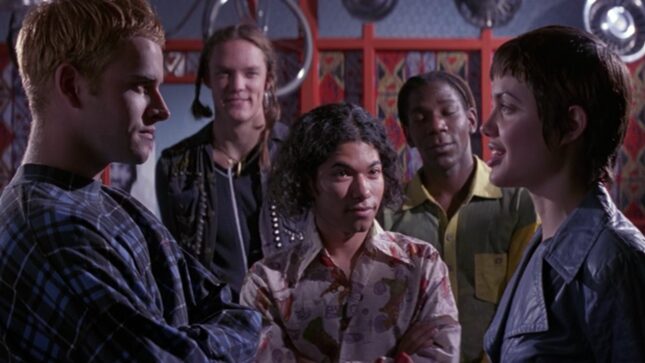Hackers Is a Glorious Cyberpunk Classic That Might Actually Say Nothing About Technology
EntertainmentMovies

No movie encapsulates the oft-maligned cyberpunk style of the ’90s and ’00s better than 1995’s Hackers, 25 years old today. The film stars Dade “Zero Cool” Murphy (Jonny Lee Miller), Kate “Acid Burn” Libby (Angelina Jolie and her haircut), Ramon “The Phantom Phreak” Sanchez (Renoly Santiago), Emmanuel “Cereal Killer” Goldstein (Matthew Lillard), Paul “Lord Nikon” Cook (Laurence Mason) and Joey Pardella (Jesse Bradford long before he reaches heartthrob status in Bring It On) as a group of high school-aged, roller-blading hackers who use their intellect for run-of-the-mill delinquent debauchery that eventually leads to real criminal activity and the necessity of finding a fraudster in order to save themselves from prison time. Or maybe they felt the altruistic need to do the right thing in the face of corrupt authority? Really, the motivation doesn’t matter, nor does the scheme, because Hackers is ultimately just a fun movie about rave clothes, a dance soundtrack (Orbital, The Prodigy, and Underworld are all represented), and an alternative reality where hacking is a skillset held by precocious, well-read teens and not political trolls looking to dismantle democracy, or whatever it is that real-life hackers do. In many ways, Hackers feels like proto-Mr. Robot—a collective of punk-y outcasts ripe for MIT who band together to create some good in the world and are almost destroyed because of it.
I’ll try not to spoil the movie, even though it is now old enough to rent a car. But the plot to Hackers isn’t what makes it worth watching—the real attraction is the snapshot of now-vintage technology, a glimpse at what top-of-the-line gadgets looked like at the time and how optimistic a future run by floppy-disc-toting teens seemed. Everyone wore colored leather and helped each other out, and nothing hurt.
The group of hackers, too, are more diverse than, say, Cher Horowitz’s Clueless crew, another coming-of-age classic released in 1995. And yet, unlike Clueless, which doesn’t sacrifice story for world-building, Hackers can get a little lost in its own ornamentation. “The gadgety new world that these techno types inhabit [attracts] legitimate movie interest, even if it still hasn’t proved gripping enough to sustain a whole film,” critic Janet Maslin wrote in The New York Times in 1995. “At first, Hackers stays enjoyable just by showing off the principals and their toys… But eventually Hackers turns tedious, perhaps not realizing that an audience can get tired of the same old equations floating in cyberspace.” The same remains true in 2020.
That said, the specificity of the film’s aesthetic lends itself to revisionist viewing. Perhaps there’s something to dissect about the teens’ ability to do what the government cannot and stop a massive cyberattack, but in reality, they would’ve been thwarted. I don’t think any of it is that serious. Hackers might simply be a movie about technology that says very little about technology 25 years on, save for the fact that an interest in techno-futurism that was once subcultural is now a dominating force in everyday life. Or that technology becomes outmoded quickly, but when tethered to cultural iconography—the roller blades, the leather jackets, the asymmetrical punk haircuts all portrayed in a celebratory film—it becomes an art object worth feeling nostalgic over.
However, would the kids of Hackers exist today, I’m sure they’d all be found drinking soylent in Silicon Valley, and who wants to consider that reality? Instead, watching the movie so many years later, I’m struck by the same details that drew me the first time I watched it: a comprehensive image of a well-developed world and the fascinating characters that live within it. Also, mesh tank tops and chain wallets. They still look cool as hell.